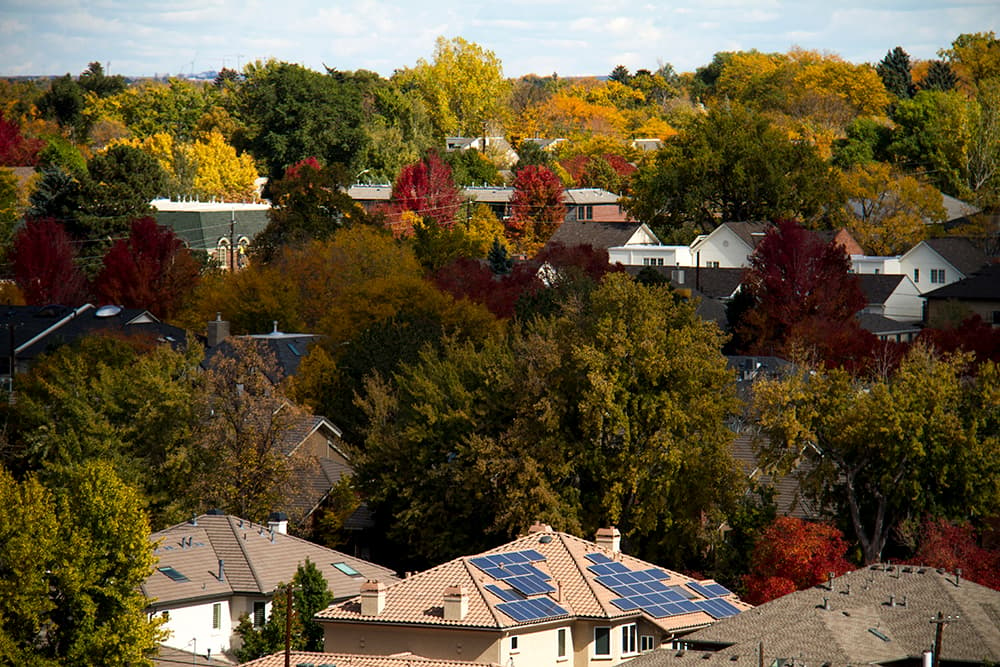The city of Denver is getting specific about how it will reduce its contribution to climate change. Over the next decades, the city could set new construction rules, collaborate on new energy facilities, supercharge electric-car infrastructure and more.
Mayor Michael Hancock introduced the city's climate-change goal a year ago, saying that Denver would reduce its greenhouse gas emissions sharply over the decades to come. It was "one of the most ambitious climate goals in the country," as NPR put it.
Yesterday, Hancock added another goal: He wants Denver to run entirely on renewable power by 2030. And, on Tuesday, his administration introduced a more detailed plan to start achieving those goals.
Here's what they might do.
Denver's specific goal is that it will reduce its carbon emissions 80 percent by the year 2050. That's compared to the emission levels in 2005.
The grid:
Denver's citywide carbon emissions are declining already, according to city analyses. They hit their highest level ever in 2007, and emissions have been falling since 2015, despite population growth. That's happening in large part because Xcel Energy, the utility, is making dramatic moves toward renewables and lower-carbon power sources.
The city could build on that progress by working with Xcel.
As we reported previously, Denver and Xcel have a new agreement that could allow them to work together to build new projects. That could include building large power plants outside of Denver; supporting rooftop and community solar in Denver; and potentially creating energy storage systems, which make renewable energy more useful.
"The technology is taking off in ways that are completely unprecedented," said Elizabeth Babcock, manager of air, water and climate for Denver. The city also could push for "customer choice programs" that allow low-income communities to buy solar and other renewable powers.
The city will not buy carbon offsets, which allow a city to pay for a carbon reduction somewhere else. It may invest in renewable-energy credits, with a focus on boosting local projects.
Transportation:
About 17 percent of Denver's carbon emissions come from transportation uses.
Hancock specifically called out electric vehicles as one possibility. "My goal would be for everyone in Denver to have the ability to have access to electric vehicles," he said. (Electric vehicles still require a power source, but a grid that's increasingly renewable means that source is getting cleaner.)
The new plan calls for the city to work with car-share companies -- such as Uber and Lyft -- to "provide access to electric vehicles and make subsidized memberships available to low-income people."
The city also could build more public charging stations; require charging stations at new buildings; and support the "electrification of local and regional delivery trucks and other heavier vehicles."
And Denver also wants to encourage more people to walk, bike and take transit, though the city has struggled to make driving less popular.
New regulations:
More than 50 percent of Denver's carbon emissions are related to energy use in buildings.
Under the plan, the city would change its building code, creating new incentives and rules about efficiency. Eventually, Denver could require that all new buildings are "net zero" energy, meaning they use renewable sources to produce as much as they consume. And it also could require owners to make "cost-effective, incremental" improvements to inefficient buildings.
Meanwhile, the city could establish a rating system that assigns an efficiency score to residential buildings, which could affect their property values. And Denver could also create energy-efficiency standards for rental housing, and it could create a "green lease" program to encourage efficiency in commercial buildings.
And Denver's residents already have forced the city into action on one front: green roofs. Last year, voters passed an initiative to require that developers and building owners plant grass and other vegetation on sections of their rooftops.
The city is likely to loosen up the requirements on that program, allowing building owners to install solar panels or reflective materials, or to pay for green space elsewhere instead.
Babcock said those changes won't hurt the city's anti-carbon quest. Green roofs are "not a huge contributor to greenhouse gas reduction," she said, and the changes provide some flexibility. Ean Thomas Tafoya, who campaigned for the green roof initiative, said that he and fellow organizer Brandon Rietheimer supported the changes.
Will it really happen?
The plan seems to enjoy support from Hancock, but there are no legal guarantees that the city will implement any of these ideas.
City officials weren't ready to put a price-tag on the plan, though they expected to have more details later this year. Many of the changes would require the city to "ramp up" existing programs, Babcock said, and the plan sets a number of milestone goals, stretching from 2020 to 2050.
About half of the reduction would be achieved by improving energy efficiency, which would save money, Babcock said. But the city also will be trying to offset its booming population.
Jeff Su, executive director of Mile High Connect, said that climate change already threatens to worsen health conditions in the West. "This will only get worse with increased heat, increased ozone and increased smoke from wildfires," he said. And an earlier city study found that the impacts would be especially bad in low-income neighborhoods.
But Denver has shown some signs of progress lately. It was recently ranked ninth in the nation on a national scorecard, and it was one of the most improved cities compared to 2015.














